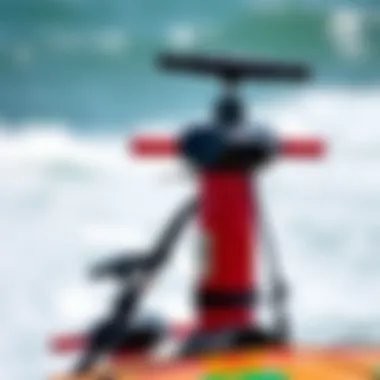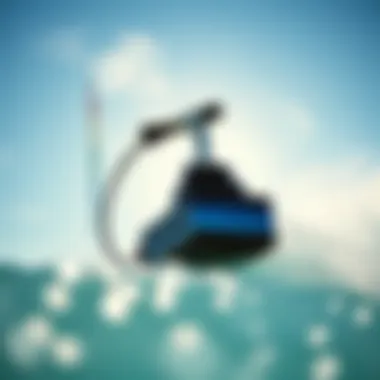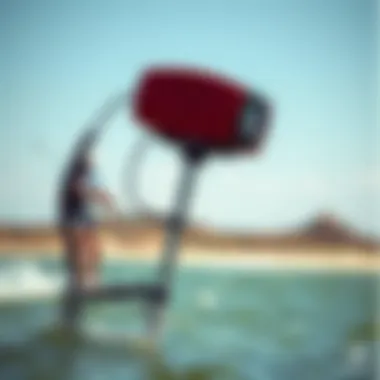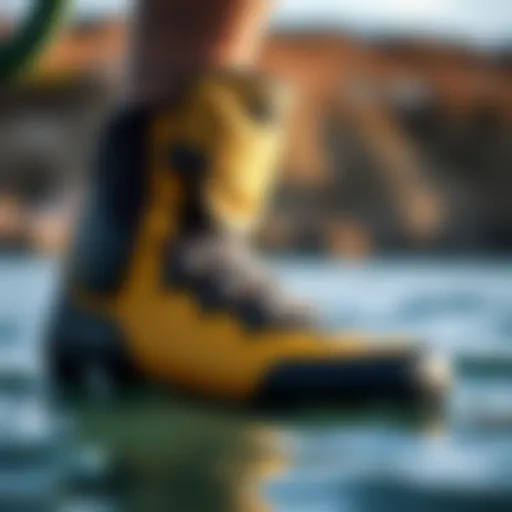Essential Tips for Choosing the Best Kite Pump


Intro
Selecting the appropriate kite pump is a decision that can truly affect your overall kiting experience. Whether you're just getting started or you're a veteran in the sport, having the right tools makes all the difference in your sessions. Many people often overlook the significance of a pump, treating it as just another piece of gear. However, investing in the right kind will streamline the process of inflating your kite, making it more efficient and enjoyable.
This guide aims to shine a light on the various types of kite pumps available, alongside the essential features to consider. From gauging performance metrics to understanding pump mechanics, we'll cover everything from the ground up, providing you with the insights necessary to make an informed choice. Additionally, we’ll delve into maintenance tips to ensure your pump remains in top condition, ultimately enhancing your kitesurfing adventures.
In the world of kitesurfing, a sturdy and efficient pump can mean the difference between a great day on the water or wasting precious time struggling with inadequate equipment. So, without further ado, let's jump into the nitty-gritty of selecting the best kite pump for your needs.
Tips and Techniques
When it comes to kitesurfing, understanding the nuances of your equipment—especially the kite pump—can elevate your skills and boost your enjoyment.
Beginner Tips for Watersports
- Choose the Right Size: A pump that’s too small or too big can lead to inaccurate inflation. Ensure your pump is compatible with your kite size.
- Practice Inflating: Get comfortable with the pump before hitting the water. This will save time and hassle when it's go-time. Familiarity breeds efficiency.
- Double-check Connections: Make sure everything is secure before inflating your kite. A loose hose can be a recipe for disaster.
Advanced Techniques for Mastery
- Utilize Pressure Gauges: Knowing the correct PSI for your kite will enhance its performance. Use a pump with a built-in gauge for accuracy.
- Minimize Air Loss: Develop quick connections and disconnections to reduce air loss while inflating. The quicker you can attach the pump, the less air escapes.
- Monitor Temperature Effects: Be aware that temperature can affect air pressure—inflate your kite accordingly when temperatures change.
Understanding how various factors influence your pump's effectiveness can lead to a smoother ride on the waves.
Safety and Gear
Safety is paramount in any watersport, and having the right gear is vital.
Essential Safety Practices
- Always Use a Kite Leash: This is your lifeline while on the water. Never underestimate its importance.
- Check Your Pump Regularly: Ensure that your pump’s hoses and mechanisms are in good condition to prevent malfunctions at crucial moments.
- Stay Hydrated and Sun-safe: Dehydration can lead to poor performance. Bring water and sunblock.
Gear Reviews and Recommendations
For gear enthusiasts, understanding the best equipment available is crucial.
- Slingshot 5th Element Pump: Widely regarded for its efficiency and durability. Great for beginners and intermediates.
- Naish Turbo Pump: Known for its quick inflation times and pressure gauge features. A favorite among advanced kiters who prioritize speed.
- Cabrinha Double Action Pump: This offers versatile options for various kite sizes and is celebrated for its sturdy construction.
By keeping these insights in mind, both novice and experienced kiters can better navigate the world of kite pumps and create an enjoyable kiting experience.
For further reading, consider visiting Wikipedia or Britannica for more information on kitesurfing techniques and safety practices.
Prelude to Kite Pumps
When it comes to kitesurfing, the efficiency of your kite pump holds considerable sway over your entire experience on the water. Selecting the appropriate kite pump is not just a matter of convenience; it can mean the difference between a joyous afternoon riding the waves and an irritating hour spent trying to gear up. Understanding the intricacies of this essential piece of equipment is paramount for anyone interested in maximizing their kiting endeavors.
Why It Matters
Kite pumps serve a singular purpose—inflating your kite to its optimal pressure. However, this straightforward function is laden with factors that can impact performance. A reliable pump helps to streamline your setup, ensuring your kite maintains its shape and responsiveness as you soar through the skies. An improperly inflated kite can be sluggish and unresponsive, leaving you feeling like a fish out of water.
Key Considerations
When delving into the world of kite pumps, there are several elements that warrant careful consideration:
- Type of Pump: Different species of pumps exist for different needs. Some kitesurfers might favor the efficiency of electric pumps, while others prefer the classic feel of a manual pump.
- Capacity and Size: The capacity of the pump impacts how quickly you can inflate your kite. Ensuring that your choice matches the size and demands of your kite can save you time and hassle.
- Durability: Opt for a pump that withstands the rigors of regular use. It’s worth investing in quality materials to avoid the headache of a pump malfunctioning just when you need it the most.
Benefits to Kitesurfers
Understanding kite pumps enhances your overall kitesurfing experience. Efficient inflation ensures your kite responds correctly, and an adept pump makes life easier during setup. Great pumps are user-friendly, saving you valuable time and energy so you can hit the water with less hassle.
As we navigate through this guide, we will explore types of kite pumps, key features to assess, best pumping practices, maintenance tips, and current market leading brands. Each section is designed to equip you with the insights needed to make an informed decision that can ultimately elevate your kitesurfing adventures. For those ready to get their feet wet in the world of kite pumps, grasping these foundational elements is the first step towards an enhanced kiting experience.
Types of Kite Pumps
When it comes to kite pumps, understanding the various types available is essential for making an informed decision. Each type offers distinct features that cater to different needs and preferences. Choosing the wrong one can lead to frustration during your kiting experience, so it’s worth investing some time in learning about them. Here, we’ll delve into three main types of kite pumps: single action pumps, double action pumps, and electric pumps.
Single Action Pumps
Mechanics and Functionality
Single action pumps operate on a straightforward principle: they inflates the kite with air on one stroke. Mostly, when you pull the handle up or down, air is pushed into the kite only during the downstroke. This makes the pumping action simple but can take a bit longer to achieve desired pressure compared to other types. The simplicity of single action pumps is one of their hallmark traits, as it provides a user-friendly option for newcomers to the kiting community. Additionally, they are often favored for their lightweight design, making them easy to transport.
Pros and Cons


Like anything else, single action pumps have their strengths and weaknesses. On the positive side, they are typically more affordable and lighter than their counterparts. For beginners, there’s less complexity to handle, which makes them an attractive choice. However, the flip side is that inflating a kite requires more physical effort and time, since air enters the kite only during one stroke. If you are out on the beach with limited time before wind conditions change, this could pose a significant disadvantage.
Double Action Pumps
Mechanics and Functionality
Double action pumps, as the name implies, fill kites with air on both the upstroke and downstroke. This means you’re effectively doubling your work output, which allows for quicker inflation. The mechanics are designed to maximize efficiency. These pumps typically incorporate a piston that alternates air flow with each stroke, making them much faster especially for larger kites. The increased air delivery per pump makes these tools particularly appealing for the seasoned kiter.
Advantages
The main advantage of double action pumps is speed. They often enable you to get your kite inflated and ready for action in a fraction of the time compared to single action pumps. This time savings is crucial on days when wind gusts are inconsistent. Additionally, they often include features like pressure gauges to help ensure that you reach the appropriate pressure without over-inflating. However, the trade-off is usually a heavier build, which might not suit everyone’s portability preferences.
Electric Pumps
Efficiency and Speed
Electric pumps represent the pinnacle of convenience when it comes to inflating kites. These devices remove the manual labor of pumping altogether, delivering quick inflation at the push of a button. They’re particularly suitable for larger kites where manual pumping could be arduous. Many electric pumps are also equipped with auto shut-off features, which means they stop inflating once the desired pressure is reached, ensuring you don't accidentally overinflate.
Considerations for Use
While electric pumps provide many benefits, there are some important considerations as well. First, they require power—often either a battery or access to a power source. Therefore, it’s not uncommon to find kitesurfers relying on electric models at beaches that lack convenient outlets. Additionally, they tend to be bulkier and heavier due to their internal components, which may limit their portability. Always assess if the benefits align with your intended use and environment.
Investing in the right pump is key to enhancing your overall kitesurfing satisfaction and performance. Considering your personal needs and preferences will help steer you towards the most fitting option.
Key Features to Assess
When venturing into the world of kite pumps, identifying the right features is of utmost importance. Not only can these elements influence the overall performance and ease of use of your pump, but they also can directly enhance your kiting experience. Understanding key features ultimately helps ensure that you choose a product that meets your specific needs, whether you are a novice or a seasoned kiter.
Pump Capacity
Understanding Volume
Pump capacity relates directly to volume, which is the amount of air that a pump can expel within a specific time frame. Understanding the volume is essential, as it dictates how long it takes to inflate your kite to the desired pressure. A pump with higher volume capacity often means quicker inflation, thereby allowing more time on the water.
Think of it like the difference between a large balloon and a small balloon. The larger balloon requires more air to fill but provides more fun once inflated. If the pump you select has a volume that doesn’t match your kite size, you might end up spending unnecessary time inflating. Thus, knowing the volume capability of your pump is a must, ensuring that you can get your kite in the air without a hitch.
Importance of Matching Capacity
Matching the pump capacity with your kite's needs is critical. A pump that can handle the capacity of your kite allows for optimal inflation without overworking the device or yourself. If you use a pump with too little capacity for a larger kite, you may find yourself straining and frustrated. The key characteristic to spotlight here is that the matching capacity guarantees effective performance as well as helps prevent potential damage to both the pump and the kite due to insufficient pressure. An imbalance in these elements can cause tears or misfires while on the water, which is something every kiter wants to avoid. Hence, choosing the right pump capacity never goes out of style!
Construction Material
Durability Considerations
Construction material plays a significant role in a kite pump's durability. Materials like polypropylene or PVC are common choices, as they are resilient to wear and tear, which is essential when constantly exposed to the elements. If a pump is made from less durable materials, it may not withstand years of use and outdoor conditions.
In practical terms, a durable construction can lead to a prolonged lifespan of the pump, ensuring that you are not out shopping for a new one sooner than necessary. After all, no one wants to be caught mid-session pumping air into a kite with a faulty pump.
Material Impact on Weight and Portability
The impact of materials on weight and portability cannot be overlooked. Lightweight materials make transportation simpler and can directly affect your kiting experience. If you plan on traveling to different locations or need to carry your gear over long distances, a lighter pump can be a game-changer.
Consider this: lugging around a bulky pump can become a chore, especially when excitement and adventure are waiting. A well-constructed pump made from lightweight material provides a seamless experience that doesn’t weigh you down, quite literally. However, keep in mind that while aiming for lightweight options, you shouldn’t compromise on sturdiness.
Pressure Gauge
Importance of Monitoring Pressure
A pressure gauge is an insightful tool that allows kiters to monitor the kite's inflation levels. Keeping the right pressure in your kite is key to achieving optimal performance. A well-inflated kite responds better to wind conditions and enhances your overall experience while riding.
The key characteristic of a pressure gauge is its ability to relay essential information quickly. Without proper monitoring, you risk over-inflating or under-inflating your kite, both of which can greatly affect performance and safety. Using a gauge means you can get it right every time.
Types of Gauges Available
When it comes to types of gauges, the market offers a range of choices, from analog to digital gauges. Analog gauges provide simplicity and can often be more affordable, making them a favored option among hobbyists. Digital gauges, on the other hand, give a precise reading which is invaluable for those who want exact performance metrics.
It's worth noting that while digital gauges generally provide more accurate readings, they may also require batteries, which can die unexpectedly. Thus, investing in a reliable type of gauge is wise for any kiter focusing on performance.
Hose Length and Fitting
Compatibility with Various Kites
There’s no one-size-fits-all when it comes to hose length and fittings. The compatibility of your pump’s hose with various kites can significantly enhance your convenience. The right length ensures you can comfortably reach your kite from various angles.


Coincidentally, having an incompatible fitting can lead to frustrating moments where you cannot properly attach your pump to your kite’s valve. It’s beneficial to check the compatibility before purchase, ensuring fun times without any hiccups.
Influence on Ease of Setup
Hose length also influences the ease of setup. A longer hose can allow greater flexibility during the inflation process, enabling you to pump without bending or reading awkward positions. Conversely, too long a hose might create tangles or require more space to manage effectively. Thus, finding the perfect balance is essential—ensuring your setup is efficient and hasty.
All these features come together to form the foundation of your kite pumping experience. Pay attention to them, and you’ll ensure not just a good buy but an investment into countless successful kite sessions ahead.
Best Practices for Pumping
In the world of kitesurfing, having the right technique can make or break your day on the water. Best practices for pumping your kite not only ensure that you inflate your gear efficiently, but they also improve safety and performance. Embracing these practices can lead to a smoother experience, allowing you to focus less on equipment hassles and more on enjoying the waves.
Preparation before Pumping
Before diving headfirst into inflating your kite, the preparation phase is crucial. It sets the tone for the entirety of your session. It’s like laying a solid foundation before building a house—without it, everything is shaky.
Inspecting the Equipment
Inspecting the equipment should be step number one on your checklist. The process mainly involves examining your pump and kite for any wear and tear. Look for cracks in the pump’s body or frayed hoses, as these issues can drastically impact your inflation time and efficiency.
A notable aspect of this inspection is that it can help to prevent mishaps during your kitesurfing adventure. A well-functioning pump means less time inflating and more time riding the wind and waves. Plus, it gives you peace of mind, knowing everything is in check.
One unique feature of this pre-pump inspection is the ability to spot potential problems before they escalate. For example, a tiny crack you notice might lead to a contributed leak during pumping. Addressing small issues before they become bigger ones is always advantageous.
Understanding Wind Conditions
Understanding wind conditions is another key aspect of preparation. Wind can change like the flip of a coin, and knowing when and how much to inflate your kite directly affects its performance. If you underinflate, you might struggle with control; overinflate, and you risk damaging your kite.
The significance of wind conditions lies in the fact that they dictate how your kite behaves once you’re on the water. A well-inflated kite in the right wind conditions offers optimum lift and responsiveness. Monitoring wind speeds and shifts helps you adapt your pumping strategy accordingly.
The unique part of grasping wind conditions can enhance your overall kitesurfing experience. It allows you to fine-tune the tension of your kite before hitting the water, therefore, maximizing performance.
Effective Pumping Technique
Once you have prepared adequately, it’s time to pump your kite. There’s an art and a science to doing it effectively, and mastering this technique is beneficial for all kitesurfers, regardless of skill level.
Tips for Efficient Inflation
A crucial tip for efficient inflation involves using the correct pumping posture. Bend your knees, keep your back straight, and use your body weight to drive the pump down. This technique can make a world of difference in energy efficiency, allowing you to pump more efficiently without burning out before you even hit the water.
Another useful approach is to perform a few quick pumps to get the initial air in and then slower, more steady strokes to fill up the kite completely. This method reduces fatigue and results in a better-inflated kite.
With these tips, you can ensure that your pumping technique is not just effective but also sustainable, making your kitesurfing adventures enjoyable.
Avoiding Common Mistakes
Avoiding common mistakes is equally vital in ensuring a successful kite pumping session. One prevalent pitfall many kitesurfers fall into is rushing through the pumping process. Inflating too quickly can lead to improper inflation, ultimately affecting kite performance.
Another common mistake is failing to check the valve seal before starting to pump. An unsealed valve can lead to a very frustrating experience, making you work harder to get your kite ready.
By steering clear of such blunders, you enhance your overall experience on the water. Awareness and mindfulness during this critical preparation stage can save a lot of hassle later on.
"A little prep goes a long way—take the time to get it right before you chase the wind."
Maintenance of Your Kite Pump
Maintaining your kite pump is not just a meticulous chore, but rather a vital action that can significantly extend the lifespan of your equipment while ensuring optimal performance on the water. Just as even the best kite has limitations without a reliable pump, any issues with your pump can lead to frustrating experiences during kitesurfing. Regular maintenance helps avoid unexpected breakdowns and ensures that your gear is ready to go when you are.
Cleaning Recommendations
Materials and Tools Required
To clean your kite pump effectively, having the right materials and tools is indispensable. Typically, you would need mild soap, a soft cloth or sponge, and possibly a soft-bristle brush for those stubborn spots. Using these materials ensures that you won’t damage your pump while still getting rid of dirt and grime.
A soft cloth is gentle yet effective for wiping down the exterior of the pump, making it a popular choice among kitesurfers. The unique feature of using soap is that it breaks down any grease or marine residue which can hinder pump efficiency. On the other hand, using harsh chemicals could potentially corrode components or affect seals, so it’s best avoided.
Frequency of Cleaning
The frequency of cleaning your kite pump significantly impacts its durability and performance. Ideally, a quick clean after each use will maintain its condition, particularly if you frequently use it in sandy or saltwater environments. This consistent care nurtures your pump’s health and keeps it functioning optimally.
Cleaning after every session may seem like a tall order, but it prevents the build-up of rust and other wear-inducing elements. Neglecting this can lead to serious issues down the line, such as blocked valves or compromised seals. Regular cleaning habits can save you time and money in repairs or replacements later on.


Storage Tips
Ideal Conditions
Storing your pump in ideal conditions avoids unnecessary wear. Aim for a dry, temperature-stable place. Direct exposure to sunlight or damp environments can lead to detrimental situations such as degradation of materials. Airing out your pump after a cleaning session can help prevent moisture from accumulating inside, which is essential to maintain its components.
Off-season storage is particularly crucial as exposure can lead to unnecessary rates of wear. Keeping it in a protective bag or case also proves beneficial. It shields against dust and physical impacts that might occur in transit or during storage.
Protecting from Damage
In addition to identifying ideal storage conditions, protecting your pump from damage is paramount for longevity. Use padded storage bags or cases specifically designed for kite pumps to shield against bumps and scratches. This is a common mistake many kitesurfers don't consider, but the right precautions ensure that your pump remains in top condition.
Moreover, be mindful to store your pump away from heavy objects which could crush or dent it. This protective practice can enhance its lifespan and aid you in avoiding unnecessary costs for replacements.
"Maintaining your kite pump not only prolongs its life but enhances your overall kiting experience."
Through conscientious cleaning and thoughtful storage, you equip yourself for an exhilarating time on the water. Your kite pump's maintenance isn't simply practical; it fosters a relationship with your gear. So, it's well worth the deliberate effort.
Market Leaders in Kite Pumps
In the ever-expanding world of kiting, the choice of equipment can dramatically influence your experience. Among the most crucial tools for any kiter is the pump, which is responsible for inflating your kite effectively. Hence, discussing the market leaders in kite pumps is essential for any kiter looking to invest in reliable and high-quality products. Brands that have established a strong foothold in the kite pump sector often reflect trustworthiness, innovation, and customer satisfaction.
Brand Comparisons
Factors Influencing Brand Reputation
When it comes to selecting a kite pump, understanding factors influencing brand reputation can significantly impact your purchasing decision. A brand’s legacy — built over years through product performance and consumer trust — plays a vital role in its standing. Key characteristics include:
- Durability: A reputable brand often invests in high-quality materials, ensuring that their pumps can withstand rugged conditions.
- Customer Service: Brands deemed reliable generally offer excellent customer support, providing peace of mind for users.
- Innovation: Leaders tend to introduce cutting-edge technology, enhancing functionality, which is crucial for consistent performance on the water.
For instance, companies such as Kookaburra and Liquid Force are often recognized not just for their pumps, but for the ecosystem they form around their products, creating a loyal customer base. The unique feature of their renowned customer service might save a lot of hassle — when it's needed — compared to lesser-known brands.
Focused Comparison on Features
Delving deeper into the focused comparison on features, one can see how different brands prioritize functionality and design elements that enhance user experience. Look for:
- Ergonomic Design: Many top-tier brands integrate ergonomic handles that reduce strain during inflation.
- Versatility: A good pump should cater to various kite types. For instance, cutting-edge pumps often include multiple nozzles for added convenience.
- Inflation Speed: The efficiency of a pump translates directly into your time on the water.
Whether it’s Slingshot with their efficient double-action pumps or North Kiteboarding offering electric pumps, understanding these fundamental features helps you recognize what sets the leaders apart from the rest.
User Reviews and Recommendations
Gathering Feedback from the Community
One cannot underestimate the importance of gathering feedback from the community when researching kite pumps. User reviews provide insights that specifications alone cannot convey:
- Real-life Experience: Learning from others’ experiences can highlight durability issues not found in promotional materials.
- Comparison of Performance: Users often share how pumps perform under different conditions, which might be pivotal when you’re out on the water.
Platforms like Reddit and dedicated kitesurfing forums often yield treasure troves of information, offering a range of perspectives on popular brands like F-One and Naish, helping enthusiasts make informed choices.
Pros and Cons from Users' Perspectives
Examining pros and cons from users' perspectives rounds out the overall evaluation of a kite pump. This comprehensive view allows prospective buyers to weigh their options:
- Pros: User satisfaction, efficiency, and reliability are frequently cited as key benefits of certain brands.
- Cons: Common drawbacks such as weight, noise (in the case of electric pumps), or even compatibility issues often surface in reviews.
Understanding these unique features of user feedback is crucial. They act as a compass guiding you toward the best options available, taking into consideration individual preferences and kiting styles.
Tip: Always cross-reference user reviews with brand reputations to get a well-rounded perspective on potential purchases.
By paying close attention to the leading brands and the community's feedback, you can make more educated decisions, ensuring your kiting experience is smooth, enjoyable, and free from equipment woes.
Closure
In the realm of kitesurfing, the choice of a kite pump can often be the unsung hero, quietly amplifying the joy of riding the waves while ensuring ease of setup. As we’ve traversed through this guide, it’s become evident that an informed decision can significantly elevate your overall experience.
Selecting the proper kite pump isn’t merely about choosing one that inflates your kite. It encompasses a multifaceted approach that includes understanding the types of pumps available—from manual to electric—and discerning the key features that genuinely matter.
"A good pump is like a trusty friend; it might not always be in the limelight, but you sure feel its absence when it’s not there."
Key Elements to Consider:
- Pump Mechanics: Knowing how each type functions allows you to align your choice with your specific needs.
- Durability: Construction material impacts not just the longevity but also affects how portable your pump can be.
- Capacity and Efficiency: Matching pump capacity with your kite’s requirements can save you time and energy during actual kitesurfing scenarios.
Understanding these nuances equips both novice and experienced kiters with knowledge that can directly influence performance on the water. In an environment where getting it just right matters, overlooking such details could result in missed opportunities for exhilarating rides or, worse, equipment failure.
Moreover, as you tend to the maintenance and care of your selected pump, you further extend its life, making it a worthwhile investment. Regular cleaning and proper storage not only keep the pump in optimal condition but also spare future frustrations when you’re ready to head out on the water.
Finally, it is wise to keep a pulse on market leaders, those brands that continually innovate and garner positive user feedback. By aligning yourself with reputable names, you’re more likely to enjoy peace of mind regarding your purchase.















